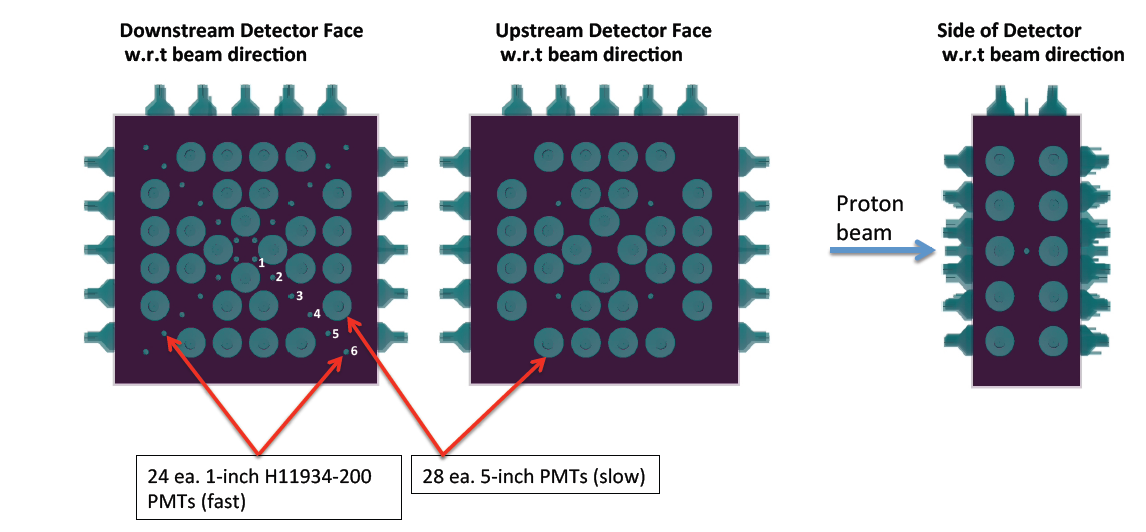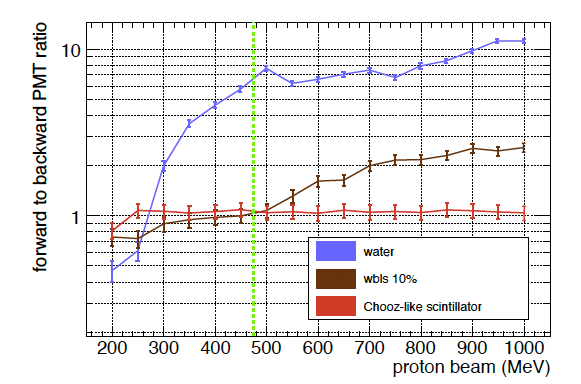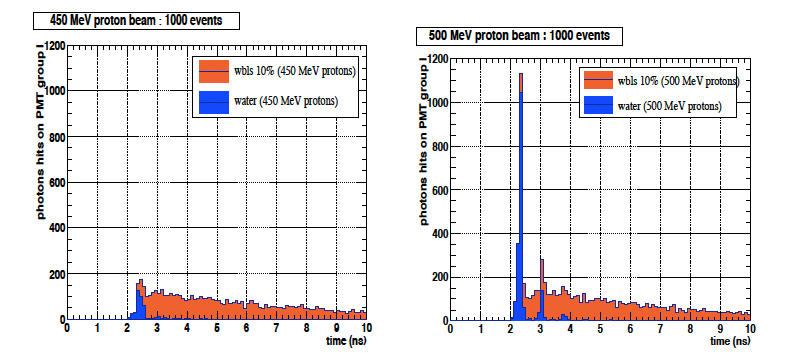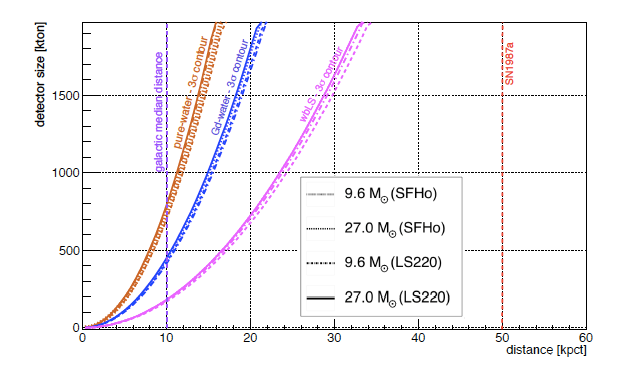Adam Bernstein (15-ERD-021)
Abstract
We examined the fundamental science potential arising from a nonproliferation demonstration detector, known as the WATer CHerenkov Monitor of AntiNeutrinos (WATCHMAN). The detector is a 3,500-ton water detector, doped with 0.1 percent of the neutron-capture agent gadolinium. While the detector is designed to demonstrate remote reactor monitoring capability for nonproliferation applications, its size and composition are such that it provides world-class sensitivity to supernova, and possible access to other neutrino properties. We developed a detailed simulation capability in order to quantify the sensitivity of this detector to fundamental neutrino physics processes. We used the capability to predict performance of WATCHMAN and similar detectors in characterizing these processes.
Background and Research Objectives
Over the last decade, gadolinium-doped water and water-based liquid scintillators (Alonso et al. 2014) have been developed as scalable media that could be used as the target medium for a very large neutrino detector (Blevis et al. 2004; Fischer et al. 2015) capable of measuring both high-energy (GeV-scale) and low-energy (MeV-scale) neutrinos. The two scintillators have been proposed as the target media for detectors that could complement the currently favored large liquid-argon detectors for the Deep Underground Neutrino Experiment (DUNE), the flagship physics program for the United States neutrino physics community (Acciarri et al. 2016). Members of our project team have been closely involved in a related effort to make use of the same media for remote monitoring of nuclear reactors for nonproliferation purposes. This nonproliferation detector development effort is now being supported by the NNSA, and is known as the WATer CHerenkov Monitor of AntiNeutrinos (WATCHMAN) remote reactor monitoring demonstration (Askins et al. 2015). While the focus of the WATCHMAN effort is nonproliferation, it became clear that the same technology had potential impact for fundamental physics at high-energy and low-energy scales (Askins et al. 2015). The objective of this project was to examine these potential impacts in detail.
We examined gadolinium-doped water (Gd-H2O) and large water-based liquid scintillator detectors. A water-based scintillator is a variant of a water-based detector in which small amounts (a few percent by weight) of a scintillant are added to the water. WATCHMAN is being designed to accommodate both fills. Both types of detector offer greater particle sensitivity than is possible with today’s technology.
The main advantage of Gd-H2O detectors over pure-water detectors and pure-scintillator detectors is a substantial increase in efficiency for neutron detection, from about 10 to 80 percent. For the most common antineutrino interaction, known as inverse beta decay, a positron and a neutron are produced via a charge current interaction of the antineutrino with protons in the water. The gadolinium dopant has the highest absorption cross section for neutrons of any element and produces an easily detectable cascade of gamma rays, totaling about 8 MeV. This robust signal permits highly efficient antineutrino detection for antineutrinos with energies above the interaction threshold of 1.8 MeV. With the neutron detected, the detector can also distinguish between the less frequent but highly directional electron-scatter events that occur for both neutrinos and antineutrinos, and the more copious inverse beta decay interactions on protons that occur only with antineutrinos. This may be beneficial for supernova detection, since a mixture of neutrinos and antineutrinos is always present in the supernova burst. The main anticipated advantages of water-based scintillators compared during this project were as follows:
- Improved energy resolution relative to pure-water Cherenkov detectors (Become and Vagins 2004), with the degree of improvement determined by the scintillator concentration, and without significant loss of the directional reconstruction compared to pure-water Cherenkov detectors.
- Improved particle identification for both low-energy and high-energy particle interactions.
- Significant improvement in vertex resolution by time-slicing the Cherenkov/scintillation waveform.
- Maintains the low cost and long attenuation lengths of pure-water detectors.
Scientific Approach and Accomplishments
We identified two key areas for consideration: phenomenology of high-energy beam neutrinos, and detection and characterization of supernovae. We used detailed simulations to demonstrate the ability to perform particle identification for high-energy neutrino-induced neutrons in neutrino beams extending to the GeV scale. (On the basis of these simulations, we submitted proposals to DOE Office of Science and to NSF to perform a 1-ton-scale demonstration of this capability.) The ability to tag neutrino-induced neutrons is an essential component of future high-energy neutrino-beam experiments to study neutrino oscillations and Charge-Parity (CP) violation in the neutrino sector. We used a detailed simulation to demonstrate the ability to characterize in detail the evolution of relatively low energy (1—20 MeV) neutrino and antineutrino species within galactic supernovae, including the possibility of measuring the mass hierarchy of neutrinos using a water-based scintillator target. The advantage of this approach is that measurement capability can be realized in a significantly smaller detector than would be possible with pure or gadolinium-doped water.
High-Energy Neutrino Physics Studies
To study the possible benefits of water-based scintillators for high-energy neutrino physics, we developed a detailed detector-simulation package. With the simulation package, we examined a key capability relevant for the realization of a large-scale multipurpose water-based liquid scintillator-filled (WbLS-filled) neutrino detector for DUNE: namely, the separation of Cherenkov and scintillation light via both timing and pattern recognition. Such a detector, if located sufficiently deep underground, would combine a sub-Cherenkov low-energy threshold with precision tracking, and would be capable of making critical measurements across several disciplines. Examples include (1) neutrino-less double-beta decay with solar-neutrino rejection capability and high isotope loading; (2) CP violation and mass-ordering measurements with almost orthogonal nuclear systematics to liquid argon detectors; (3) proton decay with an across-the-board sensitivity increase in all channels, due to sub-Cherenkov sensitivity and efficient neutron capture and proton recoil tagging; (4) 8B neutrinos and carbon-nitrogen-oxygen (CNO) solar neutrinos with lower threshold and lower background than Super-K and larger statistics than Borexino (i.e., a particle physics experiment to study low-energy, sub-MeV solar neutrinos); and (5) a measurement of geo-neutrinos with sensitivity one order of magnitude beyond existing experiments.
Cherenkov Scintillation Separation-Detector Design
We developed a detector design that is capable of isolating the Cherenkov and scintillating signals, and used our simulation tools to model its expected behavior. The preliminary experimental design consisted of a 1.2 m x 1.2 m x 0.5 m detector instrumented with 78 slow (approximately 10 ns) and 32 fast (sub-nanosecond speed) photomultiplier tubes (PMTs) distributed on five sides, as shown in Figure 1. PMTs on the detector face where the beam enters (exits) the target are referred to as the backward (forward) PMTs, which refers to the direction the emitted light travels with respect to the beam direction. The detector would be filled first with purified water, which would then be replaced with WbLS with a fractional doping of a to-be-specified scintillant. In the simulation below, we used a 10% scintillant fraction in the WbLS.
To predict anticipated results, we developed two separate but complementary analyses, referred to as the Spatial and Temporal analyses, and generated expected experimental results using our simulation package. The Spatial analysis demonstrates the ability to distinguish the different spatial patterns (forward Cherenkov cone versus isotropic) for the Cherenkov and scintillation light, and will also measure scintillation light-yield quenching as a function of proton energy. The Temporal analysis demonstrates the ability to discriminate between light types via the differing arrival times of Cherenkov and scintillation photons at the fast PMT array. Together, the Spatial and Temporal analyses, once experimentally verified, will provide convincing evidence for the utility of WbLS cocktails in much larger detectors.
Spatial Analysis
In this analysis, we separated the scintillation signal from the Cherenkov signal by examining the difference in the PMT hit pattern of photons arising from each signal type. For this purpose, we developed a (non-optimized) metric (Figure 2) given by the ratio of summed light in all (slow) forward PMTs to the same quantity in the backward PMTs. In pure water (blue trace), delta electrons appear to introduce an asymmetry even below the Cherenkov threshold of 475 MeV. In a pure scintillator, the ratio is close to one since Cherenkov light is swamped by the 100-fold higher scintillation light output. In an WbLS, a statistically significant asymmetry is observed above about 550 MeV, showing that the Cherenkov directional information is partially preserved even in the presence of a scintillation component. The error here is statistical, based on 1,000 data sets for water and WbLS; systematic effects, such as the variation in path length of the protons in the detector as a function of energy, remain to be studied. The relatively fine segmentation provided by the slow and fast PMTs will permit a more detailed pattern analysis than this metric allows. Through modeling and data, we will be able to estimate both the level of scintillant doping and the energy threshold at which the Cherenkov light remains spatially separable.
To further confirm the nature of the two spatially distinct signals in WbLS, a waveform analysis is needed to distinguish the fast (Cherenkov) and late-arriving (scintillation) components of the light. This analysis is presented in the following section.
Temporal Analysis
Cherenkov light emission consists of a wave of photons along the surface of a cone around the proton beam, outpacing most of the scintillation signal. In our simulation, fast 1-inch PMTs were arranged radially around the beam on the forward (downstream) side of the detector, with four PMTs per radial group. If Cherenkov light is present, and the radial group of interest falls within the Cherenkov opening angle, the wave of photons should arrive at all four PMTs in the group simultaneously.
Figure 3 shows the PMT hit times relative to the beam trigger for both pure water and 10-percent WbLS, as seen by the first radial group of PMTs at both 450 MeV (left) and 500 MeV (right), just below and just above the proton Cherenkov threshold, respectively. The pure-water (500 MeV) case reveals the time of arrival of the Cherenkov "wave" at near 2 ns. In the 10-percent WbLS case, the Cherenkov "wave" remains easily discernible from the slower scintillation light, highlighting the importance of the fast PMTs. At energies just below the Cherenkov threshold, nearly all the detected light is from the scintillator, which has a much slower time profile. The small signal visible below the Cherenkov threshold in water is likely due to delta rays accelerated by the proton as it traverses the detector. A combined analysis will be more powerful in terms of particle identification and tracking than either individual analysis.
Low-Energy Neutrino Physics
We analyzed the potential advances in sensitivity to supernovae characteristics that would be made possible by the use of WbLS. In particular, we made the important finding that for a fixed detector size, the neutrino mass hierarchy can be better determined for supernova at greater distances from Earth using WbLS compared to water or Gd-H2O. The ordering by weight of the masses of the different neutrino flavors, known as the neutrino mass hierarchy problem, is one of the most important unanswered questions in neutrino physics. Any measurements that can provide insight represent an important contribution to our understanding of the fundamental properties of the neutrino.
In the course of this analysis, we developed a new tagging method for neutrino interactions on oxygen in WbLS detectors, which leads to a significant reduction in backgrounds to the highly directional electron Elastic Scatter (ES) channel, compared with pure water and gadolinium-doped water detectors. We also showed that the total rate of ES neutrino and antineutrino events can be significantly enhanced due to the presence of sub-Cherenkov threshold light and increased total photon yield. We showed that models of the detailed supernova neutrino and antineutrino flavor evolution can be better constrained with large-volume WbLS detectors compared to other large-volume detectors as a consequence of the increased sensitivity to and identification of the fluxes of each antineutrino and neutrino flavor. Using a GEANT4 simulation of the WATCHMAN, a proposed kiloton-scale detector that can accommodate both Gd-H2O and WbLS fills, we provided estimates of the pointing accuracy for galactic supernovae. We also considered triggering implications for the SuperNova Early Warning System (SNEWS), a global neutrino-based warning system. We concluded the paper with a summary comparison of the supernova sensitivity of different target loadings. For the detailed analysis, refer to Abe et al. (2014). The key plot from that paper is shown in Figure 4. The plot shows that WbLS detectors can provide significantly more reach in kiloparsecs into the galaxy in order to enable three-sigma sensitivity to the neutrino mass hierarchy by an analysis of the arriving neutrino and antineutrino signal from the supernova.
Impact on Mission
Our research will help reduce the global threat from weapons of mass destruction and address scientific issues of importance to the NNSA and DOE. By demonstrating and extending the scientific potential of WATCHMAN, our work supports Lawrence Livermore National Laboratory's strategic core competency in nuclear, chemical, and isotopic science and technology.
The work performed during this project helped us to secure agreements by the Office of High Energy Physics and the Office of Nuclear Physics to contribute to the WATCHMAN nonproliferation deployment. Through our work, these two agencies agreed to permit a portion of the base grants of universities they support to be used for the WATCHMAN installation, in anticipation of the physics benefits that will arise from the detector and follow-on detectors based on the same technology. This is a major breakthrough, inasmuch as a potential nonproliferation capability is helping to advance basic science. The success is loosely analogous to that of the seismic arrays associated with the Comprehensive Test-Ban Treaty, which have been used to study the basic geology and seismic behavior of the Earth.
Conclusion
We will continue to develop the science case for water-based detectors. These detectors may have a major impact on the flagship US fundamental science effort, the DUNE experiment, and, if our nonproliferation demonstration is successful, may have a transformative effect on the global nonproliferation regime. This LDRD was essential in helping develop the synergistic science case that brought scientific funding agencies to be involved in the WATCHMAN demonstration project.
References
Abe, K., et al. 2016. “Real-Time Supernova Neutrino Burst Monitor at Super-Kamiokande.” Astroparticle Physics 81, 39—48. doi: 10.1016/j.astropartphys.2016.04.003.
Abe, K., et al. 2014. “Measurement of the Neutrino-Oxygen Neutral-Current Interaction Cross Section by Observing Nuclear Deexcitation γ Rays.” Physics Review D 90, 7: 072012. doi: 10.1103/PhysRevD.90.072012.
Acciarri, R., et al. 2016. “Long-Baseline Neutrino Facility (LBNF) and Deep Underground Neutrino Experiment (DUNE) Conceptual Design Report Volume 2: The Physics Program for DUNE at LBNF.” FERMILAB-DESIGN-2016-02.
Alonso, J. R., et al. 2014. “Advanced Scintillator Detector Concept (ASDC): A Concept Paper on the Physics Potential of Water-Based Liquid Scintillator.” Report BNL-106082-2014-JA. arXiv:1409.5864 [physics.ins–det].
——— 2015. “The Physics and Nuclear Nonproliferation Goals of WATCHMAN: A WAter CHerenkov Monitor for Antineutrinos.” arXiv:1502.01132 [physics.ins-det].
Become, J. F. and M. R. Vagins. 2004. “Antineutrino Spectroscopy with Large Water Cherenkov Detectors.” Physics Review Letters 93, 171101. doi: 10.1103/PhysRevLett.93.171101.
Blevis, I., et al. 2004. “Measurement of 222RN Dissolved in Water at the Sudbury Neutrino Observatory.” Nuclear Instruments and Methods in Physics Research A. 517: 139—153. doi: 10.1016/j.nima.2003.10.103.
Fischer, V., et al. 2015. “Prompt Directional Detection of Galactic Supernova by Combining Large Liquid Scintillator Neutrino Detectors.” Journal of Cosmology and Astroparticle Physics 08. doi: 10.1088/1475-7516/2015/08/032.
Publications and Presentations
Alonso, J. R., et al. 2015. “The Physics and Nuclear Nonproliferation Goals of WATCHMAN: A WAter CHerenkov Monitor for Antineutrinos.” arXiv:1502.01132 [physics.ins-det]. LLNL-JRNL-667040.
   








